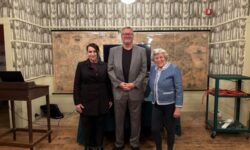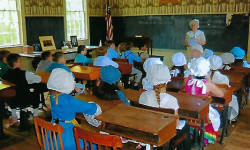[ccfic caption-text format="plaintext"]
By Richard McDonough
Hometown Weekly Correspondent
Westwood Historical Society and former Historic Commission Chairman Ralph Buonopane staged a brief presentation on the history of Westwood at the historic Fisher School.
On Valentine’s Day, the Historical Society offered an event to those who love both history and the community. Ralph Buonopane shared his expertise on town history along with a slide show comparing what use to be West-Dedham to what we now know as Westwood. Through the centuries, the town and surrounding area was home to Native American tribes, early settlers, and industrialists who all lent a hand to its development. Members of the community poured into the Fisher School to learn about Westwood in the time before now.
Tracing its official history back to 1640, the area that became West-Dedham and ultimately Westwood was thick wilderness situated between the Charles and Neponset rivers. Before being settled by Europeans, the area supported Native America tribes - most notably the Wampanoag. A lesser-known surviving tribe from the area is the Massachueuk, who to this day uphold the proud culture of their ancestors.
As new generations of American came to tame its wild terrain, the West-Dedham settlement developed alongside the greater Boston area as industry and trade were introduced. Life has changed drastically from the time of the town’s settlement, and Buonopane shared examples of commonalities between eras. Certain land formations have remained intact for centuries, standing the test of time. A notable example is Devil’s Oven rock formation, which is located in Hale Reservation. Other parts of the landscape, however, would be lost over time through the course of human habitation.
Given its proximity to Boston, West-Dedham was a key travel stop for anyone going to and from Boston when traveling west. One family instrumental in turning West-Dedham from traveling post to civilized community were the Coburns. The family accumulated land, rededicating it to timber, farming, sawmills and local businesses. Where there was work, people followed, and as more and more people settled in West-Dedham, each made their own contribution towards the town’s future. Tailors, wheel-makers, blacksmith, and leather-works numbered some of the town’s most popular professions to keep up with the needs of a rapidly-developing community. Each member of the society laid a brick in the foundation upon which the town now stands.
With the population growing, the need for governance came and to ensure the wellbeing of the community. One of the oldest and prominent examples of dedication to the future community is the Fisher School itself, which hosted the event. Built in 1845, the school now sits next to the Thurston Middle School on High Street. Now housing the Westwood Historical Society, the building stands as a monument to Westwood’s storied past.
From humble beginnings, Westwood has grown into a strong community that remains as dedicated to the common good as it did when the first settlers were shaping the town’s way of life. In looking for new ways to improve the community, Westwood should not hesitate to look back at the time before now. By examining the values, principles and traditions of the town’s past, modern-day citizens can build a stronger, more sustainable future.
























